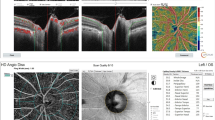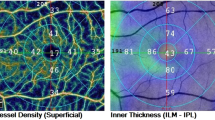Abstract
Purpose
To evaluate the correlation between flow density, as measured by optical coherence tomography angiography (OCTA), and structural and functional parameters in patients with open-angle glaucoma.
Methods
Thirty-four eyes of 34 patients with open-angle glaucoma and 35 eyes of 35 healthy subjects were prospectively included in this study. OCTA was performed using RTVue XR Avanti with AngioVue. The macula was imaged with a 3 × 3 mm scan and the optic nerve head (ONH) with a 4.5 × 4.5 mm scan. Visual field parameters [mean deviation (MD), pattern standard deviation (PSD) and visual field index (VFI)], Bruch’s membrane opening minimal rim width (BMO-MRW), retinal nerve fiber layer thickness (RNFLT) and the stereometric parameters rim area, cup/disc area (HRT III, Heidelberg Retina Tomograph, Heidelberg Engineering) were tested for correlation with flow density data.
Results
The flow density (whole en face) in the retinal OCT angiograms (superficial: p = 0.01; deep: p = 0.005), in the radial peripapillary capillary network (p < 0.001) and in the OCT angiograms of the optic nerve head (p = 0.004) were significantly lower in the glaucoma group when compared with the control group. The flow density in the RPC network correlated significantly with all functional and structural parameters tested. The strongest correlation was found between the RPC flow density (inside disc) and the BMO-MRW (Spearman’s correlation coefficient = 0.912, p < 0.001).
Conclusions
Glaucoma patients showed a reduced ONH and macular perfusion when compared with healthy controls. The flow density as measured by OCTA correlated with structural damage and visual field loss in glaucoma patients. Non-invasive quantitative analyses of flow density using OCTA provide a new parameter describing a different aspect of glaucoma, which could be useful in clinical practice.


Similar content being viewed by others
References
Tham YC, Li X, Wong TY et al (2014) Global prevalence of glaucoma and projections of glaucoma burden through 2040: a systematic review and meta-analysis. Ophthalmology 121(11):2081–2090
Flammer J, Orgül S, Costa VP et al (2002) The impact of ocular blood flow in glaucoma. Prog Retin Eye Res 21(4):359–393
Mansouri K (2016) Optical coherence tomography angiography and glaucoma: searching for the missing link. Expert Rev Med Devices 6:1–2
Coscas F, Sellam A, Glacet-Bernard A et al (2016) Normative data for vascular density in superficial and deep capillary plexuses of healthy adults assessed by optical coherence tomography angiography. Invest Ophthalmol Vis Sci 57(9):OCT211–OCT223
Lupidi M, Coscas F, Cagini C et al (2016) Automated quantitative analysis of retinal microvasculature in normal eyes on optical coherence tomography angiography. Am J Ophthalmol 169:9–23
Wang X, Kong X, Jiang C et al (2016) Is the peripapillary retinal perfusion related to myopia in healthy eyes? A prospective comparative study. BMJ Open 6(3):e010791
Liu L, Jia Y, Takusagawa HL et al (2015) Optical coherence tomography angiography of the Peripapillary retina in glaucoma. JAMA Ophthalmol 133(9):1045–1052
Jia Y, Wei E, Wang X et al (2014) Optical coherence tomography angiography of optic disc perfusion in glaucoma. Ophthalmology 121(7):1322–1332
Lévêque PM, Zéboulon P, Brasnu E et al (2016) Optic disc vascularization in glaucoma: value of spectral-domain optical coherence tomography angiography. J Ophthalmol 2016:6956717
Holló G (2016) Intrasession and between-visit variability of sector peripapillary angioflow vessel density values measured with the Angiovue optical coherence tomograph in different retinal layers in ocular hypertension and glaucoma. PLoS One 11(8):e0161631
Wang X, Jiang C, Ko T et al (2015) Correlation between optic disc perfusion and glaucomatous severity in patients with open-angle glaucoma: an optical coherence tomography angiography study. Graefes Arch Clin Exp Ophthalmol 253(9):1557–1564
Chauhan BC, Burgoyne CF (2013) From clinical examination of the optic disc to clinical assessment of the optic nerve head: a paradigm change. Am J Ophthalmol 156:218–227 e212
Gmeiner JM, Schrems WA, Mardin CY et al (2016) Comparison of Bruch's membrane opening minimum rim width and Peripapillary retinal nerve fiber layer thickness in early glaucoma assessment. Invest Ophthalmol Vis Sci 57(9):OCT575–OCT584
Spaide RF, Fujimoto JG, Waheed NK (2015) Image artifacts in optical coherence tomography angiography. Retina 35(11):2163–2180
Bonomi L, Marchini G, Marraffa M et al (2000) Vascular risk factors for primary open angle glaucoma: the Egna-Neumarkt study. Ophthalmology 107:1287–1293
Hamard P, Hamard H, Dufaux J et al (1994) Optic nerve head blood flow using a laser Doppler velocimeter and haemorheology in primary open angle glaucoma and normal pressure glaucoma. Br J Ophthalmol 78:449–453
Hafez AS, Bizzarro RL, Lesk MR (2003) Evaluation of optic nerve head and peripapillary retinal blood flow in glaucoma patients, ocular hypertensives, and normal subjects. Am J Ophthalmol 136:1022–1031
Yokoyama Y, Aizawa N, Chiba N et al (2011) Significant correlations between optic nerve head microcirculation and visual field defects and nerve fiber layer loss in glaucoma patients with myopic glaucomatous disk. Clin Ophthalmol 5:1721–1727
Nicolela MT, Drance SM, Rankin SJ et al (1996) Color Doppler imaging in patients with asymmetric glaucoma and unilateral visual field loss. Am J Ophthalmol 121(5):502–510
Michaelson I (1954) Retinal circulation in man and animals. Charles C Thomas, Springfield, IL
Mansoori T, Sivaswamy J, Gamalapati JS et al (2016) Measurement of radial peripapillary capillary density in the normal human retina using optical coherence tomography angiography. J Glaucoma 26(3):241–246
Toshev AP, Lamparter J, Pfeiffer N et al (2016) Bruch's membrane opening-minimum rim width assessment with spectral-domain optical coherence tomography performs better than confocal scanning laser ophthalmoscopy in discriminating early glaucoma patients from control subjects. J Glaucoma 26(1):27–33
Enders P, Schaub F, Adler W et al (2017) The use of Bruch's membrane opening-based optical coherence tomography of the optic nerve head for glaucoma detection in microdiscs. Br J Ophthalmol 101(4):530–535
Yarmohammadi A, Zangwill LM, Diniz-Filho A et al (2016) Relationship between optical coherence tomography angiography vessel density and severity of visual field loss in glaucoma. Ophthalmology 123:2498–2508
Shin JW, Lee J, Kwon J, Choi J, Kook MS (2017) Regional vascular density- visual field sensitivity relationship in glaucoma according to disease severity. Br J Ophthalmol 101(12):1666–1672
Funding
No funding was received for this research.
Author information
Authors and Affiliations
Corresponding author
Ethics declarations
Conflict of interest
All authors certify that they have no affiliations with or involvement in any organization or entity with any financial interest (such as honoraria; educational grants; participation in speakers’ bureaus; membership, employment, consultancies, stock ownership, or other equity interest; and expert testimony or patent-licensing arrangements), or non-financial interest (such as personal or professional relationships, affiliations, knowledge, or beliefs) in the subject matter or materials discussed in this manuscript.
Ethical approval
Participants were in accordance with the ethical standards of the institutional and/or national research committee and with the 1964 Helsinki Declaration and its later amendments or comparable ethical standards.
Informed consent
Informed consent was obtained from all individual participants included in the study.
Rights and permissions
About this article
Cite this article
Alnawaiseh, M., Lahme, L., Müller, V. et al. Correlation of flow density, as measured using optical coherence tomography angiography, with structural and functional parameters in glaucoma patients. Graefes Arch Clin Exp Ophthalmol 256, 589–597 (2018). https://doi.org/10.1007/s00417-017-3865-9
Received:
Revised:
Accepted:
Published:
Issue Date:
DOI: https://doi.org/10.1007/s00417-017-3865-9




